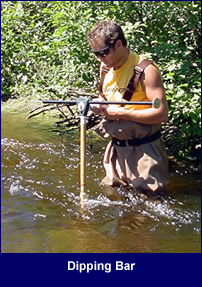Region 1: EPA New England
Dipping Bar
General Description
The dipping bar is a tool used to measure torque whose value is then used to calculate average velocity and if warranted, the present volumetric flow rate, or discharge, of a stream.
Equipment Components
- Dipping Bar Measuring rod, Weight rod, dipping bar handle & body
- Field notebook & writing utensils
Significance to Biological Integrity of Stream Ecosystem
 Stream
flow, or discharge, is the rate at which a volume of water moves
over a designated point over a fixed period of time. The flow is
related to the amount of water moving off of a watershed into the
stream channel. Flow is a function of water volume and velocity.
It is important because of its effect on water quality and aquatic
organisms, and on the shaping of the stream channel and its habitats.
From a pollution standpoint, river size and velocity is an important
factor in the water body’s capacity to assimilate waste discharges,
such as those from municipal wastewater treatment plants.
Stream
flow, or discharge, is the rate at which a volume of water moves
over a designated point over a fixed period of time. The flow is
related to the amount of water moving off of a watershed into the
stream channel. Flow is a function of water volume and velocity.
It is important because of its effect on water quality and aquatic
organisms, and on the shaping of the stream channel and its habitats.
From a pollution standpoint, river size and velocity is an important
factor in the water body’s capacity to assimilate waste discharges,
such as those from municipal wastewater treatment plants.
Resident biota are influenced by flow conditions; some species of fish and invertebrates preferring faster flowing waters and others thriving under more quiescent conditions. Bottom substrates are often determined by flow as well, providing habitat space for various aquatic organisms by scouring stream bottoms and exposing gravels and cobbles; or providing areas where finely suspended materials drop out of the water column and settle to the bottom, providing new habitat for other types of organisms. All in all, streams are very dynamic systems in which flows play a significant part.
Monitoring efforts are usually targeted for the lowest flow months of the year, (July, August, and September), when aquatic biota are the most likely to be stressed by environmental conditions and water quality conditions may be least favorable.
